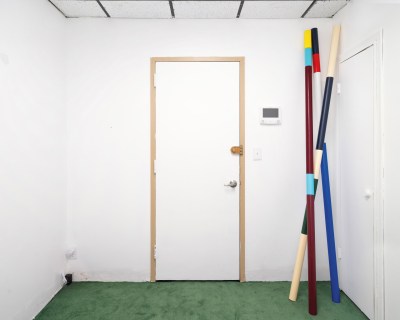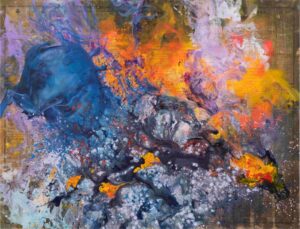Coumba Samba’s Abstractions Show How Intimacy Gets Lost in Translation

When it’s business as usual in the United Nations General Assembly, debates over international laws and their global impact are coolly waged, their real-time minutes of interest largely to diplomats and reporters. But lately, these summits have gained an unexpected follower in Coumba Samba, an artist who is fascinated by the possibility of so many representatives of different nations gathered in one room. A livestream of these summits in 2024 even constituted a piece unto itself in Samba’s show at Empire, a tiny gallery in an office building located a 20-minute walk from the UN’s New York headquarters.
Within the UN, these emissaries’ words were of great importance, with the potential to impact the world more broadly. At Empire, their statements acted as background noise to the show, titled “Dress Code.” It consisted of little more than several poles, green carpeting, and the phones and speakers that played footage of live UN meetings. Samba procured the poles from construction companies, then painted them with colored bands of irregular sizes referring to national flags. One of them prominently featured red, white, and blue, which Samba said gestured toward “colonial powers,” the flags of so many colonizer nations sharing these hues. “I’m interested in color and power,” Samba said when I met with her in New York.

View of Coumba Samba’s exhibition “Dress Code,” 2024, at Empire, New York.
Courtesy Empire, New York
Samba has exhibited canvases as well as found objects— wooden pallets, discarded radiators—painted in hues that pay homage to highly specific yet sometimes elusive sources. Stripe Blinds (2023), for example, is a broken set of Venetian blinds whose slats were painted lime green, mustard yellow, and gray, the colors of an ensemble Samba’s sister wore during her modeling days. But without these sentimental details, the work can feel cold and impersonal. In converting these stories into the ostensibly universal language of abstraction, all the intimacy is lost.
That’s deliberate. Samba’s interest in the way things get lost in translation derives from her transnational lifestyle. Born in Harlem, she was raised in Senegal for 5 years before her family returned to New York; she now splits her time between that city and various European hubs, including Basel, where, in September, she will show new work at the Kunsthalle. Shuttling back and forth across the Atlantic, she said, has allowed her to observe what she called a “causeand- effect” phenomenon, referring to trash: The refuse of European nations commonly washes up on the shores of African nations like Senegal.
A 2024 solo show at London’s Arcadia Missa featured a set of wall-mounted radiators that Samba painted in monochromes, so that they resembled the squares and rectangles one might associate with Russian Suprematist painting. The Russian connection was deliberate: An accompanying booklet featured an essay by dealer Mischa Lustin addressing what he called “red gas,” or the petroleum exported from Russia to warm homes around the world. Russia’s invasion of Ukraine resulted in sanctions on oil, Lustin pointed out, and a European energy crisis ensued. Samba’s radiators may have been monochromatic, but they were “not supposed to be complete abstraction,” she said. Instead, they spoke to global supply chains, both material and ideological.






